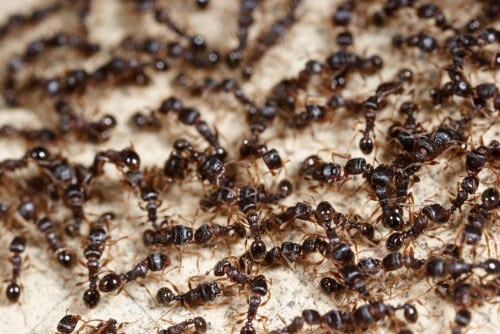
This is what Dr. Ofer Feinerman and the members of his research group, from the Department of Physics of Complex Systems at the Weizmann Institute of Science, discovered. The research findings were published in the scientific journal Nature
In ant swarms, ants that have acquired certain knowledge operate randomly, and by virtue of this knowledge they "take command" temporarily, guiding and coordinating the movement of a group of ants carrying together a load that they wish to bring to the same nest. The other ants recognize their "knowing" members, and accept their leadership temporarily, as a sort of "order of the hour". This is what Dr. Ofer Feinerman and the members of his research group, from the Department of Physics of Complex Systems at the Weizmann Institute of Science, discovered. The research findings were published in the scientific journal Nature Communications. The coordination of the collective movement of the ants ensures that the work of transporting large food items to the nest will be carried out with optimal efficiency, while preventing confusion and wasting energy by the ants from that nest.
Transportation of large cargoes by a large number of ports, while avoiding inefficiencies, requires "seeing the big picture", coordinating planning and control. However, precisely the adherence to the goal and the way as one among groups of individual ants, which fosters identical ways of conducting, may also develop in the ants of which the group is composed a reduced reactivity to changes, or a fixation of undesirable ways of conducting.
Dr. Feinerman and his colleagues used a video data analysis technique to track the movement of individual ants in a group carrying a large food item to the nest. They found that while the speed of carrying the cargo is determined by the number of ants carrying it together, the direction of the cargo transfer is affected by the short-term connection between individual ants that know very well what the exact location of the nest is.
In collaboration with the research group of Prof. Nir Gov, from the Department of Chemical Physics at the Weizmann Institute of Science, they developed a theoretical model that explains this coordinated behavior. They found that cargo-carrying ants that "know nothing" demonstrate an intermediate level of behavioral conformity, which allows the "knowing" ants to optimally guide the direction of cargo transfer. This intermediate behavior places the whole group at a critical balance point between conformism and individualism. This point is well described in the model (called the Ising model), which was originally intended to analyze phenomena in statistical mechanics.
It is customary to attribute the ability to solve problems in an anthill to the wisdom of crowds. Here, the case is reversed: the navigation solutions are found by individual ports, while the role of the group is to cooperate with these ports, and give them the power so that they can navigate the group and move the heavy cargo.
Videos taken during the study:
